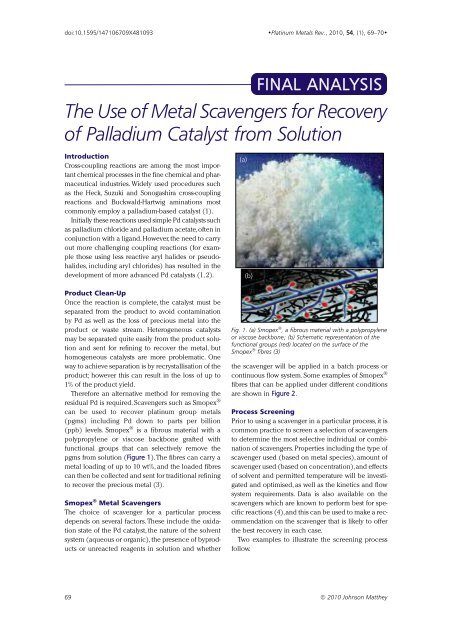Download Issue PDF - Platinum Metals Review
Download Issue PDF - Platinum Metals Review
Download Issue PDF - Platinum Metals Review
Create successful ePaper yourself
Turn your PDF publications into a flip-book with our unique Google optimized e-Paper software.
doi:10.1595/147106709X481093<br />
•<strong>Platinum</strong> <strong>Metals</strong> Rev., 2010, 54, (1), 69–70•<br />
FINAL ANALYSIS<br />
The Use of Metal Scavengers for Recovery<br />
of Palladium Catalyst from Solution<br />
Introduction<br />
Cross-coupling reactions are among the most important<br />
chemical processes in the fine chemical and pharmaceutical<br />
industries. Widely used procedures such<br />
as the Heck, Suzuki and Sonogashira cross-coupling<br />
reactions and Buckwald-Hartwig aminations most<br />
commonly employ a palladium-based catalyst (1).<br />
Initially these reactions used simple Pd catalysts such<br />
as palladium chloride and palladium acetate,often in<br />
conjunction with a ligand.However,the need to carry<br />
out more challenging coupling reactions (for example<br />
those using less reactive aryl halides or pseudohalides,<br />
including aryl chlorides) has resulted in the<br />
development of more advanced Pd catalysts (1, 2).<br />
Product Clean-Up<br />
Once the reaction is complete, the catalyst must be<br />
separated from the product to avoid contamination<br />
by Pd as well as the loss of precious metal into the<br />
product or waste stream. Heterogeneous catalysts<br />
may be separated quite easily from the product solution<br />
and sent for refining to recover the metal, but<br />
homogeneous catalysts are more problematic. One<br />
way to achieve separation is by recrystallisation of the<br />
product; however this can result in the loss of up to<br />
1% of the product yield.<br />
Therefore an alternative method for removing the<br />
residual Pd is required. Scavengers such as Smopex ®<br />
can be used to recover platinum group metals<br />
(pgms) including Pd down to parts per billion<br />
(ppb) levels. Smopex ® is a fibrous material with a<br />
polypropylene or viscose backbone grafted with<br />
functional groups that can selectively remove the<br />
pgms from solution (Figure 1).The fibres can carry a<br />
metal loading of up to 10 wt%, and the loaded fibres<br />
can then be collected and sent for traditional refining<br />
to recover the precious metal (3).<br />
Smopex ® Metal Scavengers<br />
The choice of scavenger for a particular process<br />
depends on several factors. These include the oxidation<br />
state of the Pd catalyst, the nature of the solvent<br />
system (aqueous or organic), the presence of byproducts<br />
or unreacted reagents in solution and whether<br />
(a)<br />
(b)<br />
Fig. 1. (a) Smopex ® , a fibrous material with a polypropylene<br />
or viscose backbone; (b) Schematic representation of the<br />
functional groups (red) located on the surface of the<br />
Smopex ® fibres (3)<br />
the scavenger will be applied in a batch process or<br />
continuous flow system. Some examples of Smopex ®<br />
fibres that can be applied under different conditions<br />
are shown in Figure 2.<br />
Process Screening<br />
Prior to using a scavenger in a particular process, it is<br />
common practice to screen a selection of scavengers<br />
to determine the most selective individual or combination<br />
of scavengers. Properties including the type of<br />
scavenger used (based on metal species), amount of<br />
scavenger used (based on concentration),and effects<br />
of solvent and permitted temperature will be investigated<br />
and optimised, as well as the kinetics and flow<br />
system requirements. Data is also available on the<br />
scavengers which are known to perform best for specific<br />
reactions (4),and this can be used to make a recommendation<br />
on the scavenger that is likely to offer<br />
the best recovery in each case.<br />
Two examples to illustrate the screening process<br />
follow.<br />
69 © 2010 Johnson Matthey
















